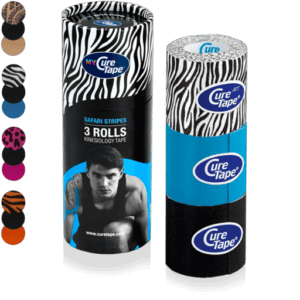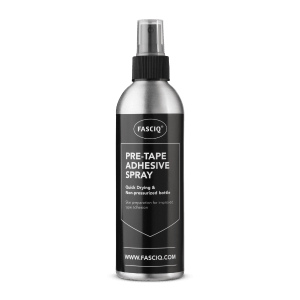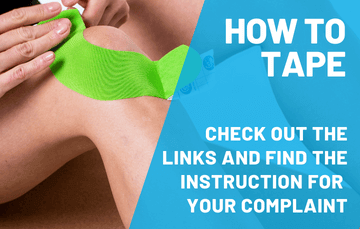The info on this page will help you prepare for a successful tape treatment, and you can click on the injury or complaint you want to tape for more information.
Want to learn how to tape yourself with kinesiology tape now? That’s great! Kinesiology tape is a therapeutic elastic tape that can be used to provide support and stability to muscles and joints while allowing full range of motion. It is also used in sports to prevent injury and aid in recovery. Learning how to properly apply kinesiology tape is a skill that can be easily acquired with a little practice.
The results of a thesis research at our company show that 79.4% of consumers who order tape from us can tape their injuries themselves. 58.15% Of this group have learnt taping a particular injury from a (physio)therapist.
Popularity of kinesiology tape
The use of coloured elastic tapes (such as CureTape, kinesiology tape, medical tape) for the treatment of various injuries and complaints has increased over the past 20 years. In approximately 75% of the physiotherapy practices, tape is used as part of a treatment.
Since a few years, the number of consumers who order the kinesiology tape directly from us has been growing. The number of physiotherapy treatments in the health insurance package is not unlimited and the tape is also not reimbursed by health insurance companies. These developments have led to the clients buying the tape themselves and taking it with them to the treatment. With instructions from the therapist, you can continue the treatment at home.
Why do people tape themselves and order CureTape kinesiology tape?
In 2021, we conducted a research among physiotherapy practices and consumers who order from us by means of a graduation project. 304 Practices and 319 consumers have completed the survey and for us there were striking results.
- 9,7% takes the tape to the practice for a treatment.
- 58,9% ordered the tape for an injury, complaint or preventive.
- 21,9% tapes for a chronic complaint.
- 9,5% otherwise: fixation tape for probes, glucose meters, cosmetic purposes and study assignments.
Of this group:
- 58.15% learned taping from their (physio) therapist.
- 6.6% learned to tape by a course.
- 25% learned it via instruction books, videos and photo instructions.

Self-taping instructions from Christina
I have chosen taping applications that are easy to apply yourself with these instructions. In order to make this treatment safe, I give practical tips, which you should take into account before, during and after a tape treatment. They are based on my years of practical experience. If the complaints persist, always consult a therapist or doctor. Good luck with taping!
Kinesiology taping: basic principles and taping information
Especially in the field of sports, the colourful tapes attract attention repeatedly. At European or World Championships, and even at the Olympic Games, there is hardly a sport imaginable in which an athlete does not compete with striking tapes.
But also in the daily practice of a therapist it is impossible to imagine life without tape. Tape is used as part of a treatment to promote the recovery process of an injury or complaint. In the case of complaints that are easy to tape or in the prevention of sports injuries the therapist teaches the client how to continue the treatment at home.
This could be irritation of the Achilles tendon, tennis elbow, calf cramps or overstretched muscles – the range of applications for using tape is virtually unlimited. For this reason, high expectations are placed on tape. The positive effect is undisputed among users, however, there is still a lack of scientific evidence. Studies do show promising results. The research is still in its infancy. What is ultimately decisive is that a perceptible and sometimes measurable change in movement occurs, often immediately after the application of a tape.
Popular products for taping
-
MYCureTape® – 3 Rolls Kinesiology Tape – Value Pack
 $26.95
In stockSelect options This product has multiple variants. The options may be chosen on the product page
$26.95
In stockSelect options This product has multiple variants. The options may be chosen on the product page -
FASCIQ® Pre-Tape Adhesive Spray
Bestseller $21.95
In stockAdd to cart
$21.95
In stockAdd to cart
THYSOL is the manufacturer of the kinesiology tape brand CureTape. As CureTape, we have been training and supplying professionals for almost 25 years. And consumers now know how to find us too! By manufacturing all our tapes in our own factory, we can guarantee the best quality!

